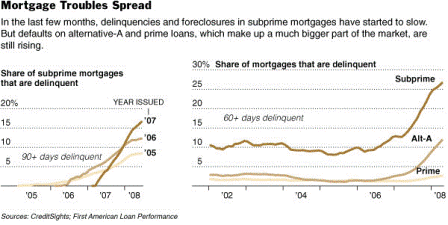>
> On Mon, Dec 22, 2008 at 12:29 PM, Bill wrote:
>
> The dominant reason loan modifications fail IMMEDIATELY is
> because the borrower’s financial condition is far worse than
> your records indicate. The most likely reason that’s true is
> that your loan officers instructed the borrower to lie on the
> original loan application so that the loan would be approved
> and the loan officer would get a bigger bonus. The next most
> common explanation is that the borrower lied on his own
> initiative.
>
> Best, Bill
>
Agreed, the primary reason for the losses is the lenders were defrauded, often by their own employees.
My proposal was for the government to let homes go into foreclosure and then buy them from the lenders at the lower of appraisal or the mortgage balance, and then rent them at fair market rents to the previous owner, with a right of first refusal on a sale which would happen a year or more in the future.
Yes, it’s an admin nightmare, but far less so than the other proposals and programs I’ve seen, and avoids issues with existing mortgage holders.
It ‘keeps people in their homes’ while at the same time provides for an orderly recycling of the homes.
But it’s never going to happen.
Also, delinquencies on the existing subprime loans seems to have leveled off for a couple of months at just under 20%, last I checked.
Warren
Mortgage re-defaults rising with no sign of slowing
WASHINGTON (Reuters) – The rate of home mortgage borrowers defaulting after their loans are modified is rising and shows no signs of leveling off, U.S. banking regulators said on Monday.
The data showed that after six months, nearly 37 percent of mortgage loans modified in the first quarter were 60 or more days delinquent. After three months, 19 percent were 60 or more days delinquent or in the process of foreclosure.
“One very troubling point is that, whether measured using 30-day or 60-day delinquencies, re-default rates increased each month and showed no signs of leveling off after six months or even eight months,” John Dugan, head of the Office of theComptroller of the Currency, said in a statement.
The number of delinquencies rose across all loan categories, although subprime loans had the highest default rates. At the same time, nine out of 10 mortgages remain current, the joint report by OCC and the Office of Thrift Supervision said.
Some U.S. lawmakers and the head of the Federal Deposit Insurance Corp have called for a more aggressive effort by lenders to modify mortgage terms to help keep people in their homes.
The data, some of which was released in preliminary form earlier this month, were based on information collected from some of the biggest U.S. institutions, such as Bank of America, Citibank and JPMorgan Chase.
[top]


